The GIGABYTE Server MW31-SP0 Motherboard Review: A Quick Look at C236
by Ian Cutress on April 21, 2016 10:00 AM EST- Posted in
- Motherboards
- Gigabyte
- Xeon
- Enterprise
- C236
Despite the fact that the MW31-SP0 is not necessarily a gaming-focused system, the use of a PLX switch suggests that GPU intercommunication is going to be a big part of the appeal to this motherboard. This can either be through gaming or compute tasks using PCIe co-processors, or if the system is paired with a few network cards to act as a switch/router or firewall when required. As a way of testing the PCIe slots, we put the board through our regular GPU tests.
Gaming Performance 2015
Our 2015 gaming results are still relatively new, but the issue of FCLK settings might play a big role here. At launch, the default setting for the communication buffer between the CPU and PCIe stack was 800 MHz, even though Intel suggested 1000 MHz, but this was because of firmware limitations from Intel. Since then, there is firmware to enable 1000 MHz, and most motherboard manufacturers have this - but it is unclear if the motherboard will default to 1000 MHz and it might vary from BIOS version to BIOS version. As we test at default settings, our numbers are only ever snapshots in time, but it leads to some interesting differences in discrete GPU performance.
Alien: Isolation
If first person survival mixed with horror is your sort of thing, then Alien: Isolation, based off of the Alien franchise, should be an interesting title. Developed by The Creative Assembly and released in October 2014, Alien: Isolation has won numerous awards from Game Of The Year to several top 10s/25s and Best Horror titles, ratcheting up over a million sales by February 2015. Alien: Isolation uses a custom built engine which includes dynamic sound effects and should be fully multi-core enabled.
For low-end graphics, we test at 720p with Ultra settings, whereas for mid and high range graphics we bump this up to 1080p, taking the average frame rate as our marker with a scripted version of the built-in benchmark.
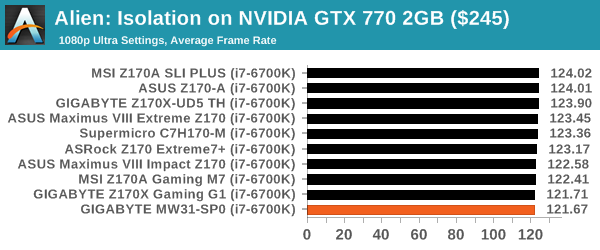
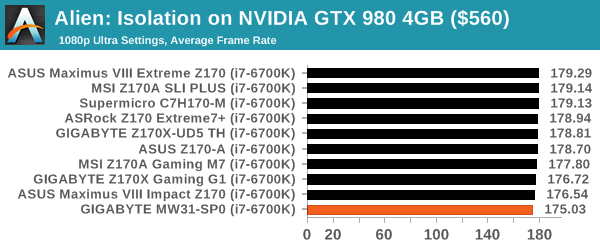
Total War: Attila
The Total War franchise moves on to Attila, another The Creative Assembly development, and is a stand-alone strategy title set in 395AD where the main storyline lets the gamer take control of the leader of the Huns in order to conquer parts of the world. Graphically the game can render hundreds/thousands of units on screen at once, all with their individual actions and can put some of the big cards to task.
For low-end graphics, we test at 720p with performance settings, recording the average frame rate. With mid and high range graphics, we test at 1080p with the quality setting. In both circumstances, unlimited video memory is enabled and the in-game scripted benchmark is used.
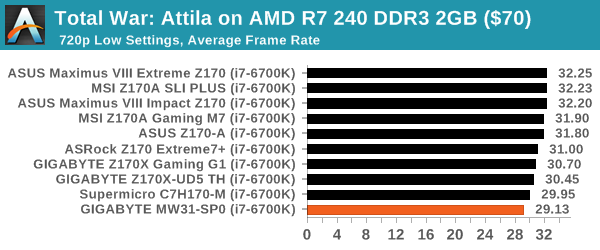
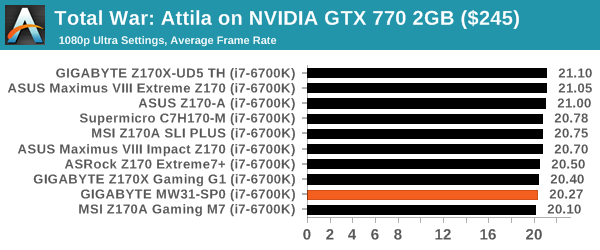
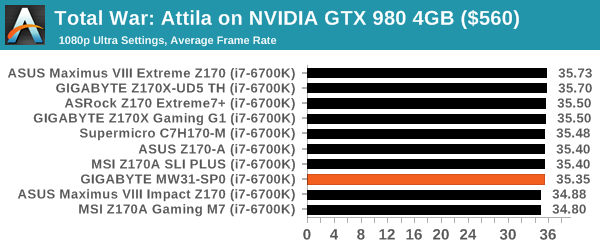
Grand Theft Auto V
The highly anticipated iteration of the Grand Theft Auto franchise finally hit the shelves on April 14th 2015, with both AMD and NVIDIA in tow to help optimize the title. GTA doesn’t provide graphical presets, but opens up the options to users and extends the boundaries by pushing even the hardest systems to the limit using Rockstar’s Advanced Game Engine. Whether the user is flying high in the mountains with long draw distances or dealing with assorted trash in the city, when cranked up to maximum it creates stunning visuals but hard work for both the CPU and the GPU.
For our test we have scripted a version of the in-game benchmark, relying only on the final part which combines a flight scene along with an in-city drive-by followed by a tanker explosion. For low-end systems we test at 720p on the lowest settings, whereas mid and high-end graphics play at 1080p with very high settings across the board. We record both the average frame rate and the percentage of frames under 60 FPS (16.6ms).

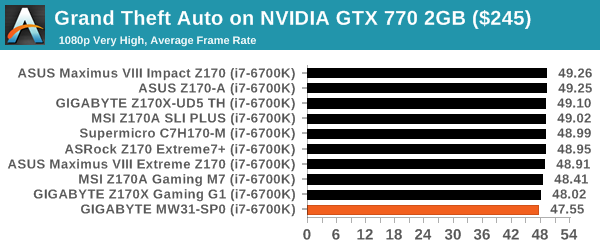
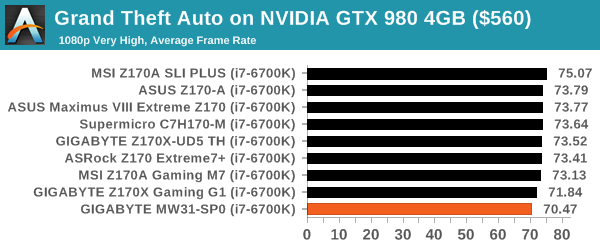
GRID: Autosport
No graphics tests are complete without some input from Codemasters and the EGO engine, which means for this round of testing we point towards GRID: Autosport, the next iteration in the GRID and racing genre. As with our previous racing testing, each update to the engine aims to add in effects, reflections, detail and realism, with Codemasters making ‘authenticity’ a main focal point for this version.
GRID’s benchmark mode is very flexible, and as a result we created a test race using a shortened version of the Red Bull Ring with twelve cars doing two laps. The car is focus starts last and is quite fast, but usually finishes second or third. For low-end graphics we test at 1080p medium settings, whereas mid and high-end graphics get the full 1080p maximum. Both the average and minimum frame rates are recorded.
Average Frame Rate / Minimum Frame Rates
Click through for full-sized images
Middle-Earth: Shadow of Mordor
The final title in our testing is another battle of system performance with the open world action-adventure title, Shadow of Mordor. Produced by Monolith using the LithTech Jupiter EX engine and numerous detail add-ons, SoM goes for detail and complexity to a large extent, despite having to be cut down from the original plans. The main story itself was written by the same writer as Red Dead Redemption, and it received Zero Punctuation’s Game of The Year in 2014.
For testing purposes, SoM gives a dynamic screen resolution setting, allowing us to render at high resolutions that are then scaled down to the monitor. As a result, we get several tests using the in-game benchmark. For low-end graphics we examine at 720p with low settings, whereas mid and high-end graphics get 1080p Ultra. The top graphics test is also redone at 3840x2160, also with Ultra settings.
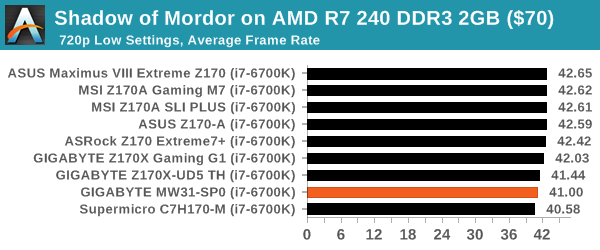
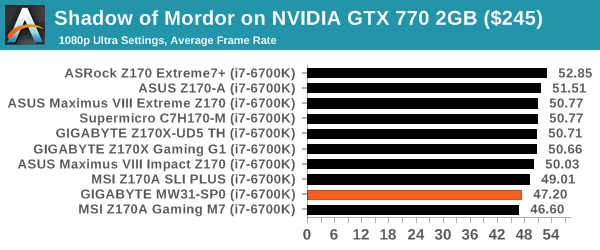
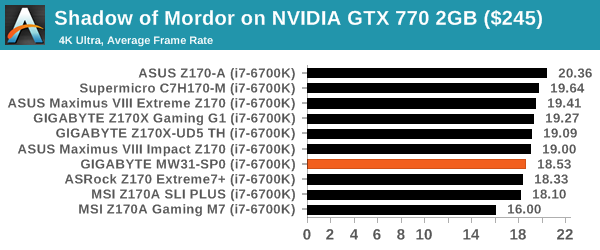
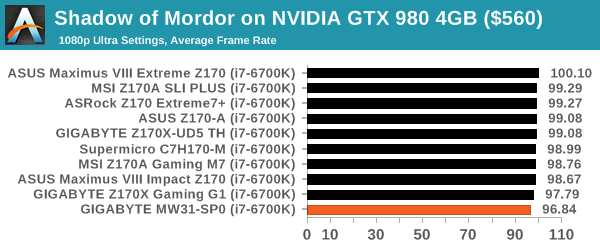
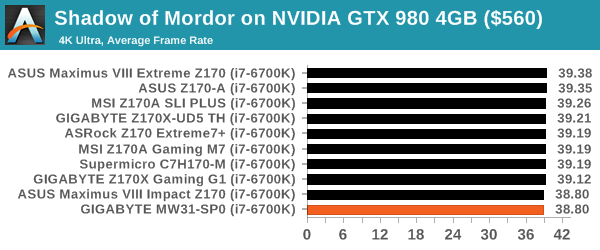







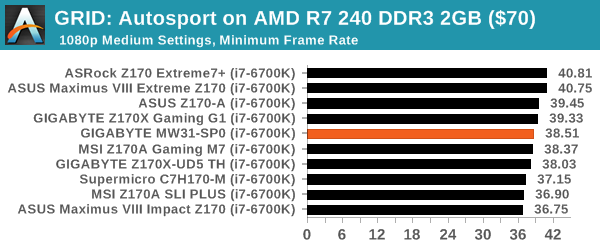
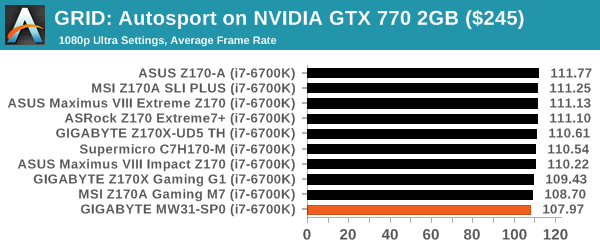
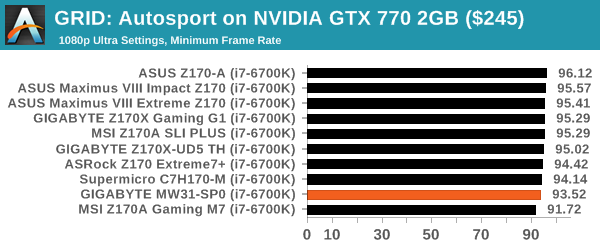
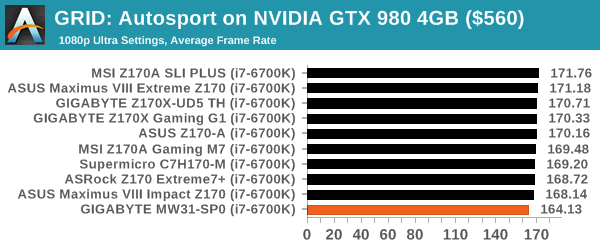
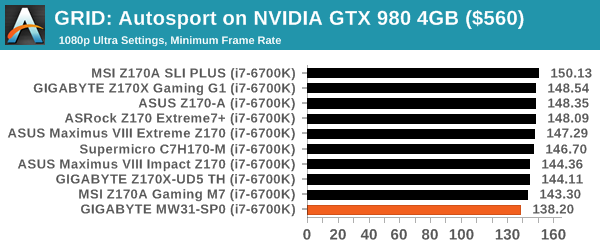









28 Comments
View All Comments
Samus - Friday, April 22, 2016 - link
C232 didn't support vPro? Wow, talk about lack of foresight by Intel...they've been trying to push that as a corporate platform basically since Sandybridge and it wasn't even supported on their server platform?SFNR1 - Friday, April 22, 2016 - link
HP uses iLO in their E3 and Intel has the RMM4 for that.Samus - Friday, April 22, 2016 - link
The problem with iLO is all the entry level servers (non-E5) have iLO light which is kind of a management joke. Most of the remote management tools require iLO advanced which can be purchased as a license for some servers but not the ML110 because the eprom isn't large enough for the software. Even then, and this is hard for me to admit because in an HP guy, Dell's iDRAC is all around better, and free, like vPro. I'm just surprised vPro was never available on C232. Generally I use remoteKVM for management so this is all moot unless I actually need to hard power off equipment remotely and since I don't manage rack servers across the country that has never come up. Only once in my career have I had to jump in the car and drive somewhere to power a server back on because I accidentally shut it down lol.rtho782 - Friday, April 22, 2016 - link
I'd like to see a comparison of SLI performance between this, with the PLX switch, and other boards that split x8/x8.I know this has been done before but nothing with modern CPUs etc.
Vidmo - Friday, April 22, 2016 - link
You should also take a look at the Supermicro X11SAT-F as its a much better board than this one or even the Gigabyte X170-Extreme ECC.http://www.supermicro.com/products/motherboard/Xeo...
snakyjake - Sunday, April 24, 2016 - link
Will using software RAID with the dual SATA controllers be an advantage, disadvantage, or no affect?milkod2001 - Monday, April 25, 2016 - link
Are there any mini atx server boards with build in 14nm Atoms/Celerons/Pentium, ECC support for NAS units out there?atlantico - Friday, April 29, 2016 - link
Gigabyte, always the last on my list for components. Ugly mobos, terribad BIOS and "ATi CrossfireX support" printed on the mobo. Why not the 3DFX SLI? Dumb and ultimately 3rd rate Gigabyte.The sad thing is that Gigabyte isn't all that much cheaper than others, except in quality.